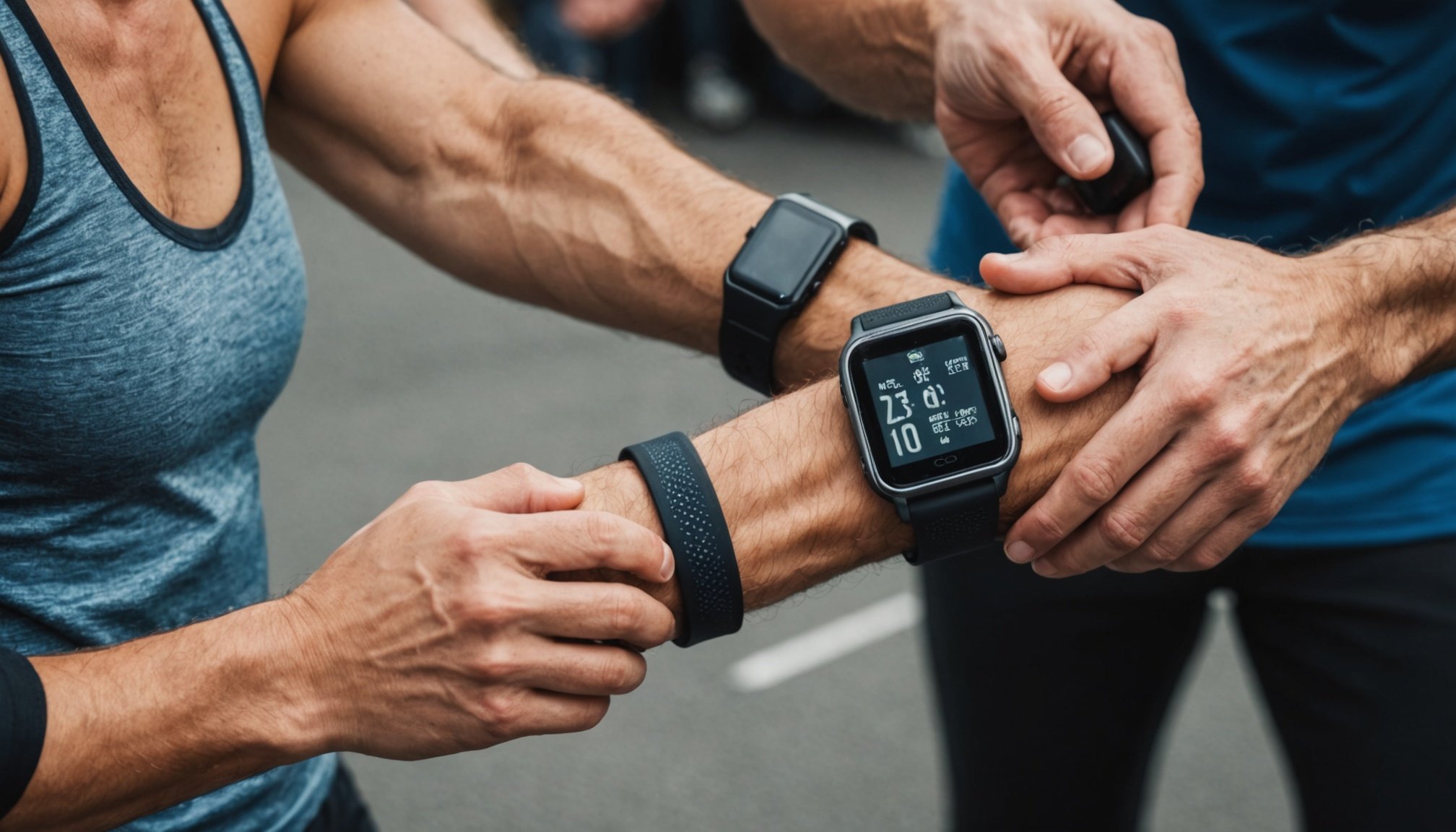Optimal Strategies for Maximizing Personal Health Monitoring with Fitness Trackers
In the era of wearable technology, fitness trackers have become an indispensable tool for anyone serious about their health and fitness. These devices offer a plethora of features that can transform your approach to health monitoring, making it more precise, personalized, and effective. Here’s a comprehensive guide on how to maximize the benefits of fitness trackers for optimal health monitoring.
Health Monitoring and Wellness
Health monitoring is one of the core benefits of using fitness trackers. These wearable devices can track a wide range of health metrics, providing you with real-time data that can significantly impact your overall well-being.
Also read : Exploring the Advantages of Gluten-Free Living for Those with Non-Celiac Gluten Sensitivity
Key Metrics to Track
- Sleep Tracking: Sleep is crucial for both physical and mental health. Devices like the Apple Watch, Fitbit, and Oura Ring can monitor your sleep cycles, helping you identify patterns and establish healthier sleep habits. For instance, the Apple Watch can track high and low heart rate notifications, irregular rhythm notifications, and even sleep apnea notifications.
- Fitness and Activity Monitoring: Keeping active is essential, and wearable devices can track your daily steps, exercise routines, and offer personalized workout suggestions. The Garmin Forerunner, for example, tracks detailed metrics for running, cycling, and swimming, and provides feedback on recovery and performance.
- Stress Management: Many wearables include stress and mood monitoring based on heart rate variability and skin temperature. This feature can help you manage anxiety and practice mindfulness. The Whoop Strap, for instance, focuses on sleep, recovery, and exercise, and can alert you when your stress levels are elevated.
Recommended Tools
Here are some of the best devices for health monitoring:
- Whoop Strap: Tracks health and fitness data, focusing on sleep, recovery, and exercise.
- Oura Ring: A minimalistic ring that tracks sleep, heart rate, and activity.
- Garmin Forerunner: Tracks detailed metrics for running, cycling, and swimming, and provides feedback on recovery and performance.
- Apple Watch: Offers high and low heart rate notifications, irregular rhythm notifications, low cardio fitness notifications, and sleep apnea notifications.
Optimizing Workout Routines
Fitness trackers are not just about monitoring health; they are also powerful tools for optimizing your workout routines.
Additional reading : Unveiling the Hidden Cardiovascular Dangers of Extended Sitting: Effective Strategies for Risk Reduction
Evaluating Workout Effectiveness
To make your workout sessions as productive as possible, it’s essential to measure their effectiveness and adapt them to your goals.
- Track Key Metrics: Start by tracking metrics such as time, distance, or weight lifted. Use a table to display your progress over weeks.
- Time and Distance
- Weight and Reps
- Sets and Rest Periods
Here’s an example of how you might track your workout progress:
| Week | Time (Minutes) | Distance (Km) | Weight (Kg) | Reps | Sets | Rest Periods (Minutes) |
|---|---|---|---|---|---|---|
| 1 | 30 | 5 | 10 | 10 | 3 | 2 |
| 2 | 35 | 6 | 12 | 12 | 3 | 2 |
| 3 | 40 | 7 | 15 | 15 | 4 | 2 |
Integrating Nutrition Tracking
Tracking your workouts allows you to systematically integrate nutrition tracking. By logging what you eat alongside your physical activities, you can identify patterns between nutrition intake and exercise performance.
- Correlate Nutrition and Performance: Use a table to map your protein, carbohydrate, and fat consumption against your workouts to better understand its effects on your energy levels and recovery.
Here’s an example of how you might correlate nutrition with workout performance:
| Day | Workout Type | Protein (g) | Carbohydrates (g) | Fat (g) | Energy Levels | Recovery |
|---|---|---|---|---|---|---|
| Mon | Running | 50 | 200 | 20 | High | Good |
| Tue | Strength | 60 | 150 | 25 | Medium | Fair |
| Wed | Rest | 40 | 100 | 15 | Low | Poor |
Leveraging Data for Personalized Workouts
Once you’ve chosen a fitness tracker, the next step is to use the data effectively. Most trackers sync with apps that provide detailed visualizations of your progress over time.
- Analyze Heart Rate Zones: Track your heart rate zones to better understand your endurance levels. Review pace and distances to improve your running routines.
- Set Specific Goals: Use the data to set specific goals and receive reminders for consistency. For example, aiming to walk 10,000 steps daily can motivate consistent physical activity, leading to improvements in cardiovascular health and general fitness.
Performance Analysis and Goal Setting
Fitness trackers are not just about tracking data; they are also about using that data to set and achieve meaningful goals.
Identifying Success Patterns
Consistent logging of workouts helps you recognize which methods work best for you.
- Document Details: Document details such as exercise types, reps, weights, and timing to identify patterns leading to personal records.
- Recognize Trends: Recognize improvement trends after adjusting certain factors, such as workout intensity or making dietary changes like a caloric deficit.
Setting Realistic Goals
Setting realistic fitness goals is essential for maintaining motivation and achieving long-term success.
- Personalized Goals: Everybody has different fitness levels and aspirations. Wearable technology can help customize plans accordingly. For instance, if someone is more focused on improving their sleep, they might pay close attention to the sleep tracking feature, adjusting their bedtime routines as necessary.
- Break Down Larger Goals: Break down larger goals into smaller, manageable targets. For example, instead of aiming to run a marathon immediately, start with smaller goals like running 5K and gradually increase the distance.
Choosing the Right Fitness Tracker
With numerous fitness trackers available, choosing the right one can be daunting. Here are some tips to help you make the best choice.
Key Features to Consider
- Heart Rate Monitoring: This feature is crucial for optimizing training intensity and ensuring you are exercising within your target heart rate zones.
- GPS Tracking: Ideal for outdoor enthusiasts and runners, GPS tracking allows for accurate mapping of routes, distance covered, and pace.
- Sleep Tracking: Features like sleep analysis can be invaluable for those looking to improve their rest and recovery times.
- Compatibility: Check device compatibility with your smartphone and the type of metrics it records.
Popular Fitness Trackers
Here’s a comparison of some of the best fitness trackers available:
| Device | Heart Rate Monitoring | GPS Tracking | Sleep Tracking | Compatibility | Battery Life |
|---|---|---|---|---|---|
| Apple Watch | Yes | Yes | Yes | iOS | Up to 36 hours |
| Garmin Forerunner | Yes | Yes | Yes | Android, iOS | Up to 7 days |
| Fitbit Charge | Yes | No | Yes | Android, iOS | Up to 7 days |
| Samsung Galaxy Watch | Yes | Yes | Yes | Android | Up to 40 hours |
| Oura Ring | Yes | No | Yes | Android, iOS | Up to 7 days |
Maximizing Battery Life
One of the common concerns with wearable devices is battery life. Here are some strategies to help you maximize the battery life of your fitness tracker.
Manage Notifications
- Limit Notifications: Tailor which apps you allow to send notifications to your watch. This can significantly reduce battery drain.
Use Power-Saving Modes
- Low-Power Mode: Many smartwatches have a low-power mode that reduces background activity, dims the screen brightness, and limits the watch to only show essential features like the time and basic fitness stats.
Uninstall Unused Apps
- Remove Unnecessary Apps: Uninstall apps you no longer use, as they can run in the background and consume battery life.
Practical Insights and Actionable Advice
To get the most out of your fitness tracker, here are some practical insights and actionable advice:
Set Achievable Goals
- “A goal without a plan is just a wish,” said Antoine de Saint-Exupéry. Setting achievable goals and having a plan is crucial for maintaining motivation and achieving long-term success.
Use All Features
- Explore All Features: Dive into all the features your device offers. For example, many fitness trackers can monitor heart rate throughout the day, provide reminders to move, and even guide you through relaxation exercises to manage stress.
Stay Consistent
- Establish a Routine: Start with smaller targets and gradually challenge yourself. Consistency is key to seeing significant benefits over time.
Fitness trackers are more than just trendy gadgets; they are powerful tools that can revolutionize your approach to health and fitness. By understanding how to use these devices effectively, you can optimize your workout routines, set and achieve meaningful goals, and maintain a healthier lifestyle.
As Matt Mullenweg, the co-founder of WordPress, once said, “Technology is best when it brings people together.” In the context of fitness tracking, this means using technology to connect with your body, understand its needs, and make informed decisions to enhance your overall health and well-being.
By following these strategies and leveraging the full potential of your fitness tracker, you can embark on a journey towards better health, one step at a time.











